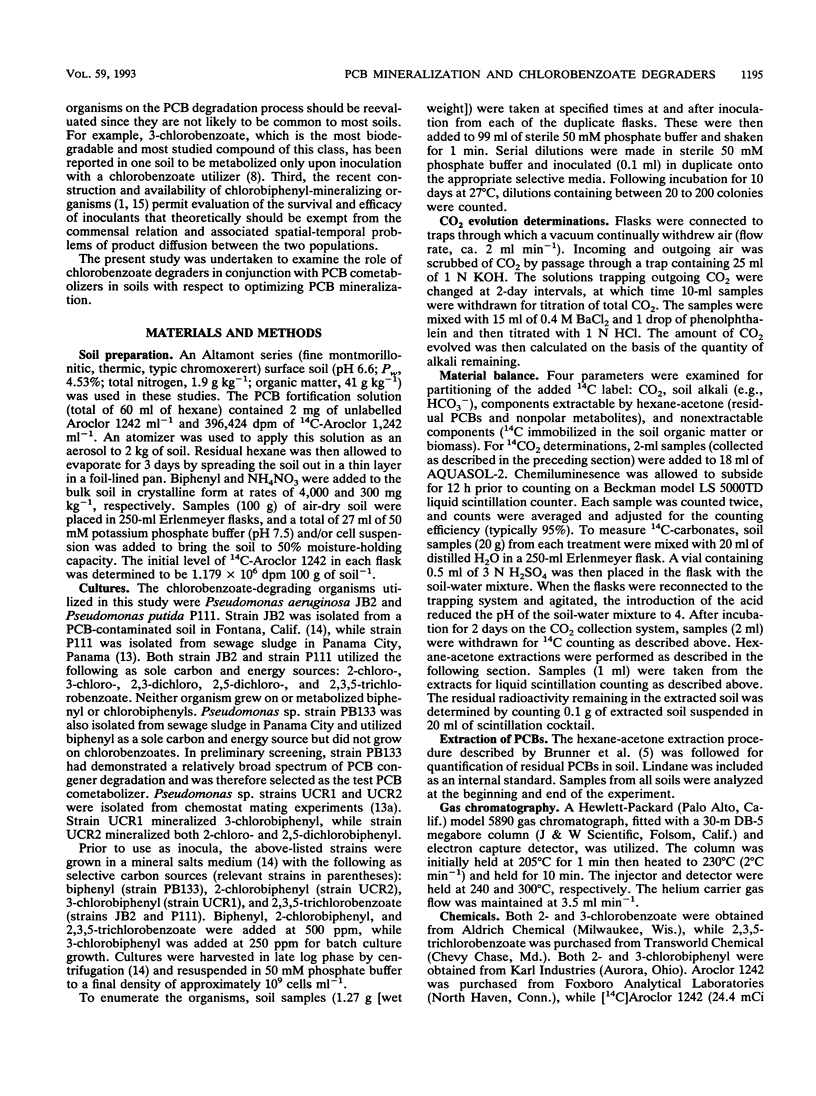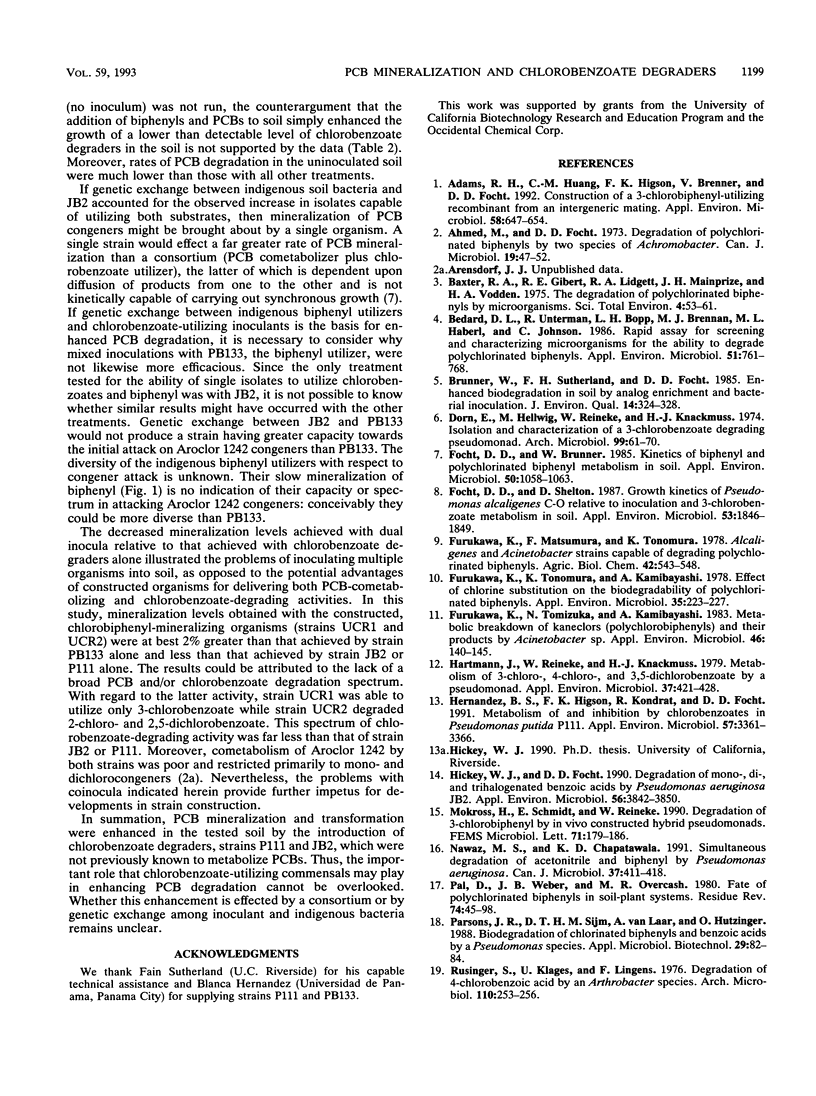Abstract
An Altamont soil containing no measurable population of chlorobenzoate utilizers was examined for the potential to enhance polychlorinated biphenyl (PCB) mineralization by inoculation with chlorobenzoate utilizers, a biphenyl utilizer, combinations of the two physiological types, and chlorobiphenyl-mineralizing transconjugants. Biphenyl was added to all soils, and biodegradation of 14C-Aroclor 1242 was assessed by disappearance of that substance and by production of 14CO2. Mineralization of PCBs was consistently greatest (up to 25.5%) in soils inoculated with chlorobenzoate degraders alone. Mineralization was significantly lower in soils receiving all other treatments: PCB cometabolizer (10.7%); chlorobiphenyl mineralizers (8.7 and 14.9%); and mixed inocula of PCB cometabolizers and chlorobenzoate utilizers (11.4 and 18.0%). However, all inoculated soils had higher mineralization than did the uninoculated control (3.1%). PCB disappearance followed trends similar to that observed with the mineralization data, with the greatest degradation occurring in soils inoculated with the chlorobenzoate-degrading strains Pseudomonas aeruginosa JB2 and Pseudomonas putida P111 alone. While the mechanism by which the introduction of chlorobenzoate degraders alone enhanced biodegradation of PCBs could not be elucidated, the possibility that chlorobenzoate inoculants acquired the ability to metabolize biphenyl and possibly PCBs was explored. When strain JB2, which does not utilize biphenyl, was inoculated into soil containing biphenyl and Aroclor 1242, the frequency of isolates able to utilize biphenyl and 2,5-dichlorobenzoate increased progressively with time from 3.3 to 44.4% between 15 and 48 days, respectively. Since this soil contained no measurable level of chlorobenzoate utilizers yet did contain a population of biphenyl utilizers, the possibility of genetic transfer between the latter group and strain JB2 cannot be excluded.
Full text
PDF






Selected References
These references are in PubMed. This may not be the complete list of references from this article.
- Adams R. H., Huang C. M., Higson F. K., Brenner V., Focht D. D. Construction of a 3-chlorobiphenyl-utilizing recombinant from an intergeneric mating. Appl Environ Microbiol. 1992 Feb;58(2):647–654. doi: 10.1128/aem.58.2.647-654.1992. [DOI] [PMC free article] [PubMed] [Google Scholar]
- Ahmed M., Focht D. D. Degradation of polychlorinated biphenyls by two species of Achromobacter. Can J Microbiol. 1973 Jan;19(1):47–52. doi: 10.1139/m73-007. [DOI] [PubMed] [Google Scholar]
- Baxter R. A., Gilbert P. E., Lidgett R. A., Mainprize J. H., Vodden H. A. The degradation of polychlorinated biphenyls by micro-organisms. Sci Total Environ. 1975 May;4(1):53–61. doi: 10.1016/0048-9697(75)90014-5. [DOI] [PubMed] [Google Scholar]
- Bedard D. L., Unterman R., Bopp L. H., Brennan M. J., Haberl M. L., Johnson C. Rapid assay for screening and characterizing microorganisms for the ability to degrade polychlorinated biphenyls. Appl Environ Microbiol. 1986 Apr;51(4):761–768. doi: 10.1128/aem.51.4.761-768.1986. [DOI] [PMC free article] [PubMed] [Google Scholar]
- Dorn E., Hellwig M., Reineke W., Knackmuss H. J. Isolation and characterization of a 3-chlorobenzoate degrading pseudomonad. Arch Microbiol. 1974;99(1):61–70. doi: 10.1007/BF00696222. [DOI] [PubMed] [Google Scholar]
- Focht D. D., Brunner W. Kinetics of biphenyl and polychlorinated biphenyl metabolism in soil. Appl Environ Microbiol. 1985 Oct;50(4):1058–1063. doi: 10.1128/aem.50.4.1058-1063.1985. [DOI] [PMC free article] [PubMed] [Google Scholar]
- Focht D. D., Shelton D. Growth kinetics of Pseudomonas alcaligenes C-0 relative to inoculation and 3-chlorobenzoate metabolism in soil. Appl Environ Microbiol. 1987 Aug;53(8):1846–1849. doi: 10.1128/aem.53.8.1846-1849.1987. [DOI] [PMC free article] [PubMed] [Google Scholar]
- Furukawa K., Tomizuka N., Kamibayashi A. Metabolic breakdown of Kaneclors (polychlorobiphenyls) and their products by Acinetobacter sp. Appl Environ Microbiol. 1983 Jul;46(1):140–145. doi: 10.1128/aem.46.1.140-145.1983. [DOI] [PMC free article] [PubMed] [Google Scholar]
- Furukawa K., Tonomura K., Kamibayashi A. Effect of chlorine substitution on the biodegradability of polychlorinated biphenyls. Appl Environ Microbiol. 1978 Feb;35(2):223–227. doi: 10.1128/aem.35.2.223-227.1978. [DOI] [PMC free article] [PubMed] [Google Scholar]
- Hartmann J., Reineke W., Knackmuss H. J. Metabolism of 3-chloro-, 4-chloro-, and 3,5-dichlorobenzoate by a pseudomonad. Appl Environ Microbiol. 1979 Mar;37(3):421–428. doi: 10.1128/aem.37.3.421-428.1979. [DOI] [PMC free article] [PubMed] [Google Scholar]
- Hernandez B. S., Higson F. K., Kondrat R., Focht D. D. Metabolism of and inhibition by chlorobenzoates in Pseudomonas putida P111. Appl Environ Microbiol. 1991 Nov;57(11):3361–3366. doi: 10.1128/aem.57.11.3361-3366.1991. [DOI] [PMC free article] [PubMed] [Google Scholar]
- Hickey W. J., Focht D. D. Degradation of mono-, di-, and trihalogenated benzoic acids by Pseudomonas aeruginosa JB2. Appl Environ Microbiol. 1990 Dec;56(12):3842–3850. doi: 10.1128/aem.56.12.3842-3850.1990. [DOI] [PMC free article] [PubMed] [Google Scholar]
- Kutsuna M., Someda K., Morita K., Yamanouchi Y., Kurimoto T., Kawamura Y., Matsumura H. [Ischemic cerebral symptoms after subarachnoid hemorrhage due to aneurysmal rupture (author's transl)]. No Shinkei Geka. 1978 Jun;6(6):543–548. [PubMed] [Google Scholar]
- Mokross H., Schmidt E., Reineke W. Degradation of 3-chlorobiphenyl by in vivo constructed hybrid pseudomonads. FEMS Microbiol Lett. 1990 Sep 1;59(1-2):179–185. doi: 10.1016/0378-1097(90)90053-s. [DOI] [PubMed] [Google Scholar]
- Nawaz M. S., Chapatwala K. D. Simultaneous degradation of acetonitrile and biphenyl by Pseudomonas aeruginosa. Can J Microbiol. 1991 Jun;37(6):411–418. doi: 10.1139/m91-067. [DOI] [PubMed] [Google Scholar]
- Pal D., Weber J. B., Overcash M. R. Fate of polychlorinated biphenyls (PCBs) in soil-plant systems. Residue Rev. 1980;74:45–98. doi: 10.1007/978-1-4612-6096-7_2. [DOI] [PubMed] [Google Scholar]
- Ruisinger S., Klages U., Lingens F. Abbau der 4-chlorbenzoesäure durch eine Arthrobacter-Species. Arch Microbiol. 1976 Nov 2;110(23):253–256. doi: 10.1007/BF00690235. [DOI] [PubMed] [Google Scholar]
- Sklarew D. S., Girvin D. C. Attenuation of polychlorinated biphenyls in soils. Rev Environ Contam Toxicol. 1987;98:1–41. doi: 10.1007/978-1-4612-4700-5_1. [DOI] [PubMed] [Google Scholar]
- Sondossi M., Sylvestre M., Ahmad D. Effects of chlorobenzoate transformation on the Pseudomonas testosteroni biphenyl and chlorobiphenyl degradation pathway. Appl Environ Microbiol. 1992 Feb;58(2):485–495. doi: 10.1128/aem.58.2.485-495.1992. [DOI] [PMC free article] [PubMed] [Google Scholar]
- Sylvestre M., Mailhiot K., Ahmad D., Massé R. Isolation and preliminary characterization of a 2-chlorobenzoate degrading Pseudomonas. Can J Microbiol. 1989 Apr;35(4):439–443. doi: 10.1139/m89-067. [DOI] [PubMed] [Google Scholar]


